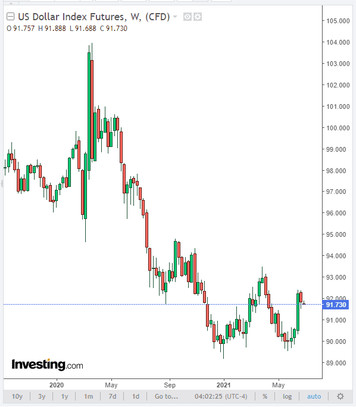Last week, the US broad market S&P 500 index renewed its all-time high at 4286.0. For the S&P 500, the past week was the best since February. Also, the high-tech NASDAQ100 rose to new records last week, and the industrial DJIA, although it could not renew its absolute record reached in May at around 35090.0, fully recovered from the losses incurred the previous week, adding 3.7% to its notional value.
Optimism, which suffered a little after the Fed meeting in the middle of the month, returned to the American stock market. Although its leaders did not change the parameters of the current monetary policy of the central bank, keeping key interest rates in the range of 0.00%-0.25%, and the volume of the QE asset purchase program at the same level of $ 120 billion per month, there is still something in the sentiments of some leaders has changed. Now they forecast two rate hikes in 2023, whereas they previously promised not to raise rates until the end of 2023. Already 7 representatives of the FOMC against 4 in March expect the start of rate hikes already in 2022.
These changes in the expectations of the Fed's leaders regarding the prospects for monetary policy alerted investors, forcing many of them to fix profits in short positions on the dollar and in long positions on stock instruments, in particular, on stock index futures.
As a result, in the week from June 13 to June 19, a strong decline was recorded in the stock market, which had not been observed since the end of February.
Nevertheless, the head of the Fed, Jerome Powell, who spoke in Congress last week, managed to calm market participants a little. He reiterated that the Fed's primary task is to support the American economy and the labor market, which have been severely affected by the pandemic. The rise in inflation, in his opinion, is a secondary, albeit no less important problem. The Fed will not rush to tighten monetary policy, relying on inflation alone, and only with the cumulative dynamics of inflation growth and a full recovery of the labor market the central bank can begin to change the parameters of monetary policy, Powell said.
As a result, the major US stock indexes finished the past week, as we indicated at the beginning of this article, with a noticeable increase, while the DXY dollar index declined.

As of this writing, the DXY dollar index is at 91.73, 11 points below Friday's close.
This week is transitional between June and July and between the 1st and 2nd half-years. And, as always, market participants will wait for new drivers and new benchmarks when determining the direction of further dynamics of the dollar and stock indices.
Therefore, the publication of monthly data from the US labor market on Friday (at 12:30 GMT) will be extremely important this week. In general, a very optimistic report from the US Department of Labor is expected, according to which 675,000 new jobs (outside the agricultural sector) were created in the American economy in June, and unemployment was at 5.6%.
Market participants will closely monitor this publication, reacting violently as always to changes in previous reports and deviations from the forecast. Accordingly, deviations for the better will cause the dollar to strengthen and US stock indices to rise. Although, it is often difficult to predict the market reaction to the publication of indicators. Probably the most cautious investors will choose to stay out of the market during this time frame. Until Friday, most likely, the market will be trading in a range close to the current levels.
One way or another, major US stock indices, including the S&P 500, maintain a long-term positive trend. Optimism still prevails on global stock exchanges, associated with expectations of a further recovery in the global economy, both against the backdrop of the unfolding vaccination against coronavirus in Europe and North America, and the extra-soft policy of the world's largest central banks. And for today the publication of important macro statistics is not planned. A flat is expected, which could be disrupted for some time if the Fed representatives John Williams (the head of the Federal Reserve Bank of New York and a member of the FOMC) and Randal Quarles (a member of the Board of Governors of the Federal Reserve and its Deputy Head for Banking Supervision), whose speeches are scheduled for 13: 00 and 17:10 (GMT), will make unexpected statements regarding the Fed's monetary policy. If they do not bring up this topic, the market reaction to their speeches will be weak.





